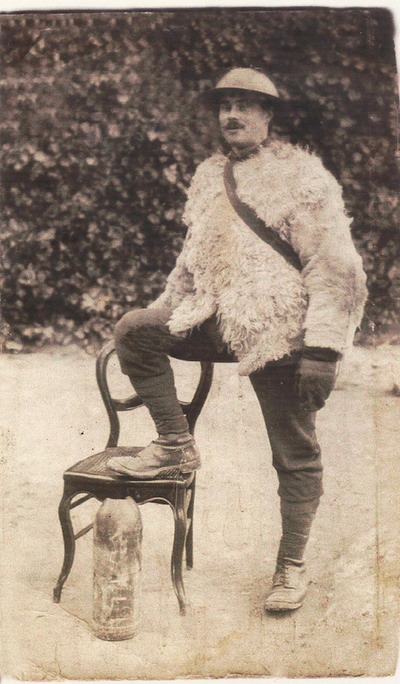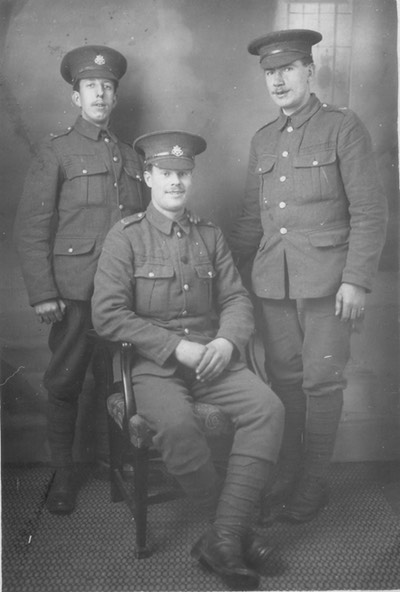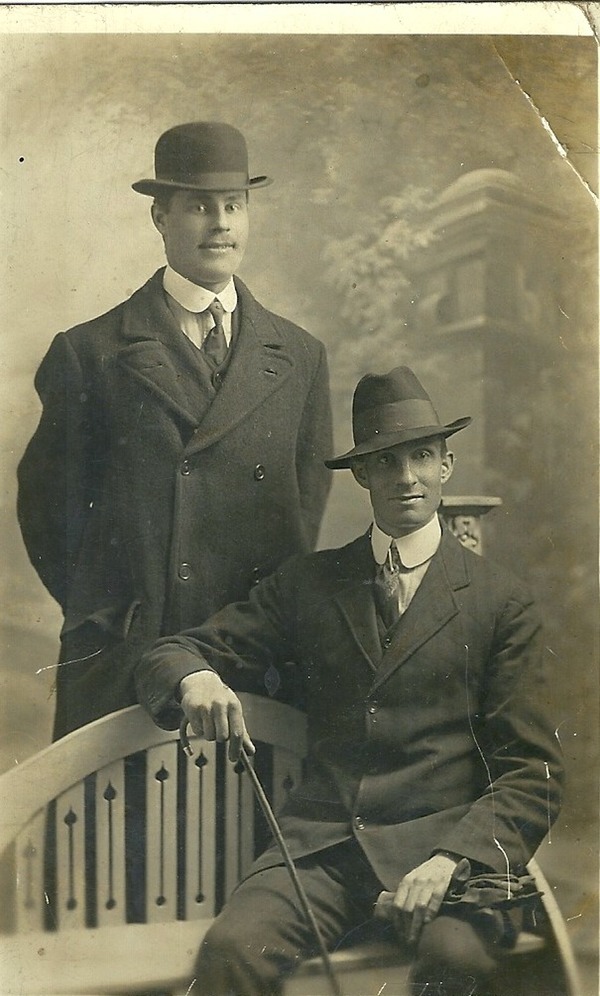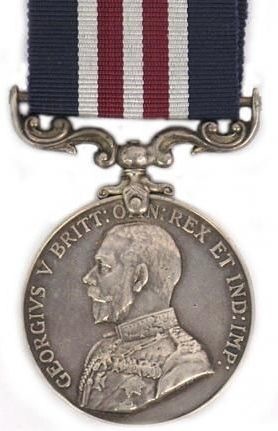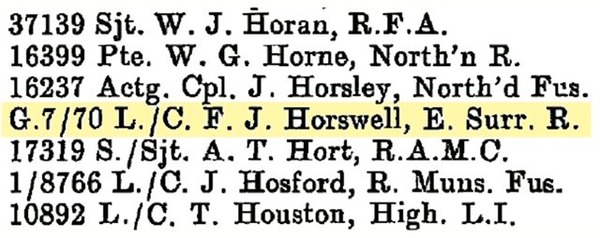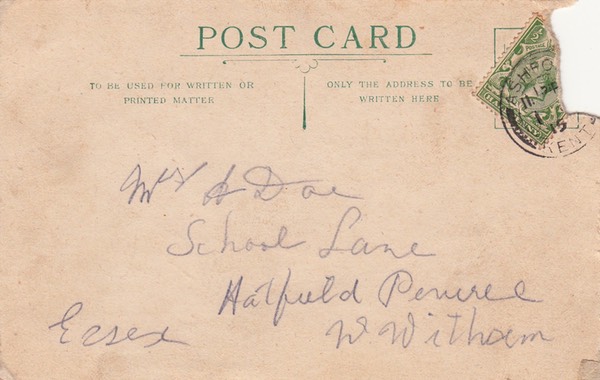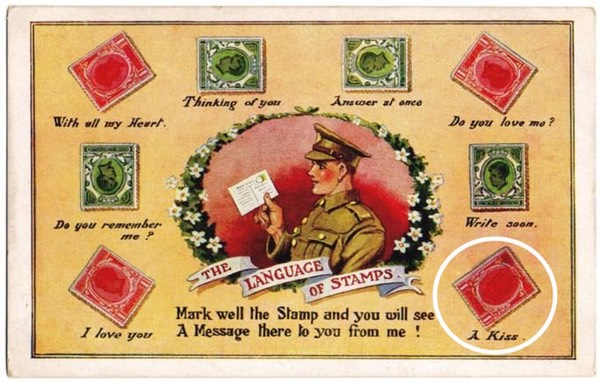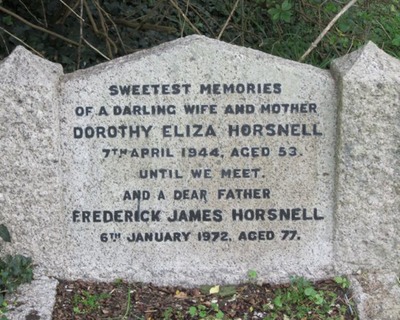“With love from her loving brother F.J.Horsnell” it says on the back of this U.S.A. Studios photograph of c.1912–14.
The photograph is dated from the distinctive logo on the back, in use by U.S.A. Studios between 1912 and 1915.
Fred is standing, wearing an overcoat, bowler hat, jacket, round-collared shirt and tie. This is the only pre-war photograph known to exist of Fred, aged 18–20. The man seated is unidentified.
Frederick ‘Fred' James Horsnell was born 8th July 1894 in the village of Hatfield Peverel, Essex. He was the second son (and third child) of Alice and Robert Horsnell.
At the time of the 1911 census, Fred, aged 16, was living with his mother and step-father, Arthur Doe. He’d left school and his occupation was given as "gardener".
On 3rd August 1914, Germany invaded Belgium and declared war on France. As Britain was allied with France, Britain responded on 4th August by declaring war on Germany.
Signs up for duty
In its edition of 5th August, the Daily Express (a national British newspaper) carried the front page headline: England Expects That Every Man Will Do His Duty.
Fred was among the first to volunteer for duty, aged 20.
On 12th August, eight days after Britain entered the war, Fred enlisted into A Company, 7th Battalion the East Surrey Regiment. His army service number was 70, and his rank was Private.
Three days after Fred enlisted, on 15th August, his elder brother, Charles, who was in the regular army, embarked for France with the British Expeditionary Force (BEF).
Service record
Fred’s military service record survives, unlike that of many First World War soldiers whose records were destroyed in September 1940, when a German incendiary bomb struck the War Office repository in Arnside Street, London.
His service record is summarised here:
|
Extracted from Ministry of Defence service records |
|
| 12th August 1914 | Enlisted at Kingston-upon-Thames, Surrey, into the 7th Battalion East Surrey Regiment (service number 70; rank Private) |
| 1st June 1915 | Embarked for France |
| 12th November 1915 | Promoted Lance Corporal |
| 1st May 1916 | Returned to UK |
| 12th May 1916 | Promoted Corporal |
| 15th June 1916 | Embarked for France |
| 8th May 1917 | Returned to UK |
| 31st January 1918 | Posted to 4th Battalion East Surrey Regiment |
| 27th July 1918 | Attended Signal Course at Army Signal School, Dunstable, Kent, and qualified as Instructor |
| 12th December 1918 | Posted to 3rd Battalion East Surrey Regiment |
| 20th March 1919 | Demobilised |
From Fred's wartime letters home it’s possible to add details not recorded in his MoD record, enabling a clearer picture of his military activity to emerge:
- September–October 1915: saw action in the Battle of Loos;
- March 1916: wounded in the left ankle during fighting at the Hohenzollern Redoubt; sent to a Canadian field hospital on the French coast at Le Tréport;
- July 1916: saw action in the Battle of Albert (the opening offensive operation in the Battle of the Somme), and was awarded the Miliitary Medal for conspicuous service;
- December 1916: hospitalised as a result of wet conditions in the trenches;
- May 1917: wounded in the hand during the Battle of Arras; sent to Whitecross Military Hospital, Warrington;
- September 1917: transferred to Eastern Command Depot, Shoreham-by-Sea, Sussex (Shoreham Camp).
The Hatfield Peverel Parish Magazine of August 1917 refers to Fred and the injury to his hand, saying: “Fred Horsnell is still in hospital, his hand is giving trouble, and it is feared another operation would not be advisable.”
We learn more about Fred’s hand injury from his letter of 4th August 1917, in which he writes: "They have done nothing to my hand yet. They seem doubtful whether they can do it any good or not."
Medals
Fred was awarded four medals – three campaign medals and one gallantry medal:
- Military Medal
- 1914–15 Star
- British War Medal
- Victory Medal
Fred was awarded the Miliitary Medal for conspicuous service at the Battle of Albert (1916) during the First Battle of the Somme.
In both the official history of the East Surrey Regiment, and the London Gazette (the official government newspaper), Fred’s surname was recorded as “Horswell”.
A secret message?
Fred embarked for France on 1st June 1915. That day he sent a postcard to his mother with his news, saying “We are now on our way.”
At first sight, that’s as much as he appears to say. But, perhaps there’s more to it than just a few words written on the back of a postcard.
As this postcard was posted in Britain, Fred had to buy a stamp for it.
The postal rate for a postcard was 1/2d (half-penny) and the card showed the sender exactly where to place the stamp in the top right-hand corner.
How the position of stamps could be used to convey hidden messages to recipients. This postcard was clearly intended for use by soldiers writing to their families and loved ones.
Instead of placing the stamp neatly over the pre-printed postioning rectangle, Fred stuck it at an angle of about 45 degrees.
Was he rushing to board the troop ship and placed the stamp in haste? Or, as is more likely, did he deliberately put the stamp at an angle in order to send a secret message to his mother?
There was a well established tradition of positioning stamps in such a way in order to convey a message to the recipient.
In Fred’s case, the position of the stamp was intended to send this message to his mother: “A Kiss”.
Family and later life
In 1917 or early 1918, Fred became engaged to Dorothy Eliza Adkiss (née Hayes), affectionately known as “Dora” (1891–1944). Dora was a widow, with a daughter, Gladys, from her first marriage.
In a candid undated letter, possibly from February 1918, written by Dora to her future sister-in-law Dot (Fred’s youngest sister) she says that “Fred is getting excited over the wedding” and that “I have not the slightest doubt … Fred will make me a good husband. He has every appearance of being so as he has taken to little Gladys – that’s what I like about him. It’s funny and strange he should have met me after he had given Annie up. But still I have read your letters and seen what you thought of her and it was not much, although of course Fred couldn’t see it earlier. But never mind, he doesn’t care now. Perhaps things happen for the best. What say you, dear?"
In this same letter, Dora confides in Dot about her wedding dress, saying she is leaving it “till the last week”, and that it might be “fawn, grey or blue”. As for a wedding gift, an “eiderdown would be nice” or “half a tea service, as I had one when I first got married but unfortunately it’s got broken”.
Dora says to Dot how she would have liked the wedding to have been “from here” (she writes from 7 Middle Road, Kingston by Sea, near Brighton), but that Fred has “preferred it from his home” and that she is “satisfied” with that. Only in wartime could a bride’s plans for her big day have caused her to say “As long as the air raids keep away from us”.
Fred and Dora were married on 30th March 1918 at St Andrew’s Church, Hatfield Peverel. They had two children, Ivy (b.1919) and Charles (b.1921).
The family lived at 51 Queen Street, Worthing, West Sussex, in a house called “Peverel”, named for the village of Hatfield Peverel, 100 miles to the north-east, where Fred was born. The house remained in the family for many years and was eventually bought 1971–72 by Fred's granddaughter, Elizabeth.
The house that Fred built
Fred worked in the building trade. A family story recounts how he built houses in Worthing. As a finishing touch, he would set a penny into the wall, above the front door. Fred’s grandson, Jeffrey, remembers his grandfather pointing out Worthing's "penny houses" to him in the 1950s.
Fred was a keen gardener, with three allotments in Worthing (gardening was Fred’s first occupation on leaving school, up until joining the army in 1914).
Fred died 6th January 1972, aged 77, at Shoreham-by-Sea, West Sussex, and is buried at Durrington Cemetery, Worthing.
Information request
If you have information or photographs relating to Frederick James Horsnell, please use the contact form to get in touch.
In particular, information leading to the current whereabouts of Fred’s medals is sought. They were stolen in a house break-in in the early 1970s, and were not recovered at that time. They are likely to be ‘out there’ somewhere today, perhaps as part of a collection, but where? The family would very much like to know.
Also, if you know of any houses in Worthing with pennies (old, pre-decimal pennies) above their front doors, do please get in touch.
Selected sources
London Gazette, 12th September 1916 (fifth supplement 14th September 1916).
Col Hugh W Pearse and Brig-Gen H S Sloman, History of the East Surrey Regiment, vol II, 1914-1917 (London, 1923).
Mrs Esther M. Doe, Hatfield Peverel, 11th April 1982, pers comm. Letter from a family member married to Jim Doe, half-brother of Frederick Horsnell.
Ministry of Defence Archives, Hayes, 8th February 1983, pers comm. Letter detailing Frederick Horsnell’s military service record.
Mr Jeffrey Horsnell, Peacehaven, East Sussex, and Mrs Elizabeth Richards (née Horsnell), Cape Town, South Africa, grandchildren of Frederick Horsnell, August 2014, pers comms. Information regarding theft of medals, 'penny houses’ and family home in Worthing.
